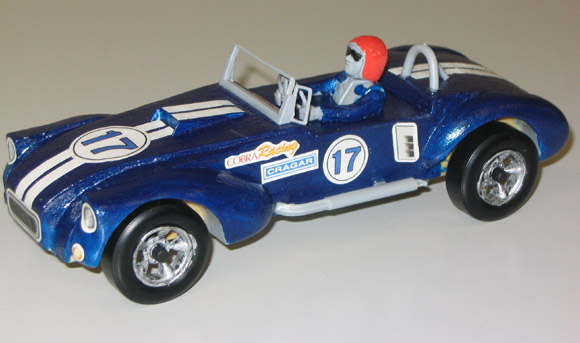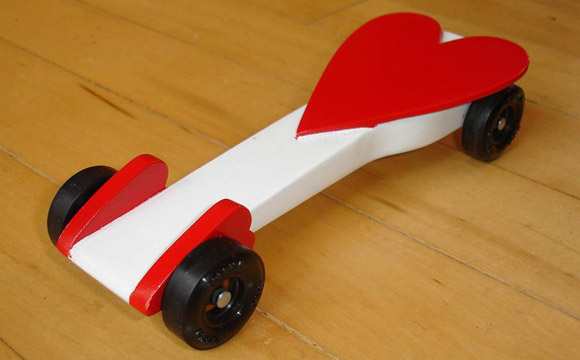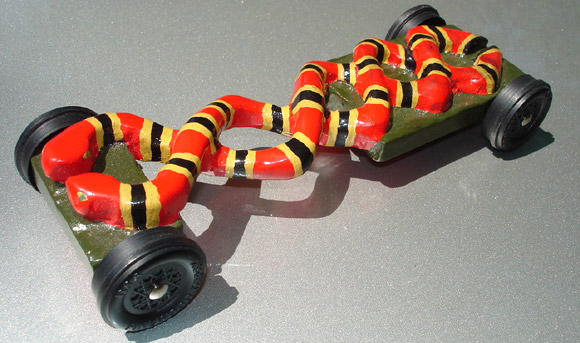– Feature Article – Remote Control Race Management
– Pinewood Derby Car Showcase
– Memory – Pinewood Derby Victory
– Q&A
Remote Control Race Management
By John Shreffler
The basics of the pinewood derby are simple enough: Using parental guidance, produce a car that is both unique and fast. Fast is perhaps more important than anything else (since it is a race), so serious attention must be paid to accurately calling each race.
Race management has come a long way over the years. Although there are pinewood derby races still being called by human judges standing over the finish line, each year more and more organizations are realizing that the eyeball is not quite up to the task of sorting out the finish order of a close heat.(1) Clearly the electronic finish line has become the gold standard for pinewood derby race management.
Simultaneously, the integration of the electronic finish line into a comprehensive PC-based race management application has become the norm. No more charts and grease pencils; no more indecision, errors, and time-consuming re-runs. Once the contestant’s names are all entered into a data base during check-in, the total heat structure is defined in a fraction of a second, and the derby is managed step by step with space age precision. Even the award certificates can be printed on the spot to take home and tape to the refrigerator door. The focus is now on the kids and their cars – exactly where it should be.
So what is next? One clear trend is to make more use of the computer by managing the audio and video presentation to the crowd. Sound effects of roaring engines and squealing tires are popular, and so are clips of Indy races between heats. Also, the race action is projected on large screens using one or more cameras located in strategic locations.
Recently a new pinewood derby embellishment, a remote control start gate, is getting a lot of attention. It is quite dramatic to see the pegs drop with nobody around to manipulate the start gate. Better yet, a lot of fun and excitement can be added to the race by allowing participants to start the race with a remote control.
The magic ingredient at work is the solenoid, which is a coil of wire that creates a magnet when hit with an electrical current. A plunger within the coil responds by moving along the coil’s axis. There are two basic ways to use a solenoid: Most start gates are ‘cocked’, or drawn into the closed position by human power against a spring. Once the gate is cocked, a relatively small solenoid can be used to replace the human finger action of releasing the starting gate. However, a larger solenoid can provide sufficient power to provide the complete gate movement, eliminating the need to perform a manual reset between heats..
Last summer, I ordered seventeen different solenoids of various capacities to get a feel for the size and power that would be needed to perform these two actions. Here are some tips that I learned along the way:
- You cannot, in general, get enough power from common alkaline batteries to achieve remote control. You can use 12 volts, but you will need at least a gel-cell, or a motorcycle battery. Obviously a car battery would work, but that is over-doing it.
- Overall, using 120 VAC is the most practical way to get the required force.
- The 120 VAC solenoid found in washing machines is unnecessarily powerful.
- A minimum solenoid to get useful work has a coil at least one inch in diameter by two inches long.
- The pull of a solenoid is always weakest when it is extended and strongest when the plunger is pulled all the way into the coil. It would be really nice if the opposite were the case, but it is not. Therefore, it is very important to have a solenoid with enough power when the gate is in the closed position (i.e., the plunger is extended).
- Make sure the hinges on the starting gate are in perfect alignment, and they don’t bind.
- Use minimum spring tension to keep the gate closed. If you are using DC solenoids, have the circuitry store power and release it in the first few milliseconds.
- Start the timer with an independent switch, not upon application of power to the solenoid. One thing I learned early in the discovery process is that there is a degree of uncertainty introduced into the timing between application of power to the solenoid and the position of the plunger along the axis. This is due in part to the force weakness at maximum extension, and in part to the phase of the current when applied. There is also a temperature effect; that is, the available power suffers as the solenoid heats up. Certainly, these are small factors; but remember that electronic finish lines are capable of measuring elapsed time to fractions of a millisecond.
Click Here to see some of my remote control designs.
The author, John Shreffler, manufactures The Judge electronic finish line, as well as light trees and starting gates.
(1)There are still some groups that use electronic finish lines, but back them up with humans who must agree. Of course, there are also folks that are still hanging on to their 8-track stereos in case CDs don’t prove out!
Pinewood Derby Car Showcase
Blue Cobra: Randy & Dalton West
The blue Cobra that my son, Dalton, and I made was from a hobby kit. It was supposed to be easier so he could do most of the work. Wrong! Nothing lined up on the pre-cut wood frame. So it was back to the sandpaper. We had to sand the sides down so the plastic fenders would line up; they were a pain to glue on and to get where they looked right. After that, he did a nice paint job. The car ended up taking 2nd Place.
Heart Attack: Jeff & Mara Lilleskare
After winning 1st Place for speed last year, my daughter Mara wanted to try to win a style award. She liked the American flag theme of last year’s car, but wanted to incorporate hearts this year to make it appear more ‘girly’. She sketched out some ideas, and to help her out I bought a bunch of different heart cut-outs from a craft store. She just kept re-arranging them until she came up with a design she liked. When we were part way through with painting, she was so pleased with how it was turning out, that she decided not to add the additional blue heart decals and designs she had originally planned – thus was born the ‘Heart-Attack’.
We had a blast building it together, and she loved trying to incorporate the tips and tricks we found on Maximum Velocity – although she was very tired of axle polishing and sanding by the time we were done! She ended up winning 3rd for design, accomplishing her primary goal, and we were extremely surprised to also end up winning 3rd for speed. Overall a great year, and she was extremely proud to have the only car in recent memory to place in both categories.
Snake Trouble: Cory Jackson, Jr.
This was a fun car I made for the Dad’s Division at the pack meet. I had to use a variety of tools to make it, including a scroll saw, Dremel tool, router (for weights) etc. I used the Pro-Wheel Shaver on the wheels, and tungsten for weighting. No prizes for looks, but I did manage to whip the competition in speed!
Pinewood Derby Memory
Pinewood Derby Victory
Last year, at the District Pinewood Derby, we learned just how much difference a rough wooden track can make! On the first run down the track, we had an axle get pushed backwards as we hit a rough spot in the track, resulting in the car being out of alignment.
So this year, we were determined to improve performance. To guard against a similar mishap as last year, we prepared the car for a rough ride by reinforcing the front end with good ol’ automobile body and fender putty (Bondo).
A few days before the race, we started tuning the car. First, we did an initial test run to get a baseline. Ryan, my son, placed his car on the track, read the results from a window on my laptop, and entered the time into a spread sheet. He also spun the wheels and operated a stop watch. By working on his car, Ryan not only learned about wood working and painting, but he also learned about averages, statistics and the affect of different lubricants on surface friction. Most importantly, he learned how to have fun with technology. Some people say, “Oh, that Pinewood Derby is a dad’s thing”. Yes, I enjoy it, but Ryan has participated in every step of the process, and he enjoys it as well.
We were fine tuning his car right up until an hour before the race. After a short half-hour drive, we arrived at the race location, the Jim Falls Lions Club. We made sure we were about a half hour early so we would have time to adjust our maximum car weight to the limit of 5.00 oz. Ryan handed his car to a scout leader at the judge’s stand and was told it was 5.02 ounces. Perfect, I had my drill in hand, ready to drill some lead out. The judges scale had three significant figures and we had to get two of them to zero (5.00 oz). As other cub scouts arrived and weighed-in, my drill became more and more popular as other fathers discovered that their kid’s cars were overweight..
After a few announcements and an explanation of how the race would be judged, the racing began. There were 25 contestants and six lanes on the track. To make it as fair as possible, each boy’s car ran six races, one race on each lane of the track.
Ryan’s car won the first race against five other cars. They rotated all the cars to the next lane to the left, which bumped us off the track. We would not race again until all of the other 25 contestants had raced at least once. Then after about 10 races, a problem was discovered. They decided that there was corruption in the process, or the computer had a glitch; something had gone wrong enough that it justified a restart.
This time, we took second place out of the group of six cars. So now we were just hoping for a possible second or third place. Many races went by as we waited our turn to get back on the track. We noticed some very fast cars, a low-rider type red car, a pickup truck, and a yellow one had many first place wins in their six races. Finally we got a chance to race, and took first place five times in a row! In one heat, there was a tie for second place that required them to rerun the heat, but we took first again.
Then, they announced the top seven qualifiers. Ryan’s name was not called first or second. I was concerned for a minute (we have been overlooked before in the Pack race, and I had a feeling that it could happen again). But after the third or fourth name, they announced, “Ryan Wolff”.
In the first race of the finals Ryan’s car took first; we beat the guy who had at one time beaten us. Then, like before, we were booted off the track as they rotated lanes, but this time only for one race. We came back onto the track to win another first place, and continued to win every race thereafter.
They announced the third place winner and Ryan’s name was not called.
They announced the second place winner and Ryan’s name was not called.
They announced the first place winner and Ryan’s name WAS called. They gave him a plaque and a trophy.
So, now that Pinewood Derby season is over, what do we do in the off-season? I wish there was another level of racing for us.
Von Wolff
Q&A
Our local rules on wheels reads as follows: “No wafering, tapering or other similar shaving of the wheels is allowed. Remove the extra plastic and mold projections from the wheel tread by light sanding. No wheel bearings, washers, bushings etc. are permitted.” My interpretation is that the guideline, “no wafering, tapering or similar shaving”, is directed at the wheel tread surface, and therefore, removal of wheel material from the interior would not be a rule violation. Understanding this is a local rule and needs to be clarified by the local derby officials, I wanted to see if, based on your experience, do you have any input on how this may be interpreted?
Clearly, the intent of the rule is to prevent modifying the tread surface. Probably, the idea of removing material from the interior was not considered. However, since our Pro Ultra Lite Wheels (part #5065) are noticeably different (thin edge), the officials could say the wheels were ‘wafered’, horizontally not vertically. So, you would be safer to use the Ultralight Speed Wheels (part #5080), which are lighter in weight, but not noticeably different in appearance. In any case, I encourage you to check with the race officials ahead of time to make sure that the wheels you intend to use will be considered legal.
What is the best coating material for axles? Zinc or nickel?
Most axles are plated with zinc to resist rust and corrosion. However, some speed axles are coated with nickel. Most people think that nickel plating is the best as it is a harder finish. This harder material is less prone to scratching, and has a lower coefficient of friction. Note however, that zinc-plated axles have a dull, aluminum-colored finish. Nickel-plated axles are shinier, and do stand out somewhat.
Will NyOil II affect the paint on the car?
NyOil II isn’t a solvent, so you should not have a problem with paint contact. We have used it with Krylon-brand paints and automobile paints with no problem, and I haven’t heard of any NyOil-paint issues.
Want Answers?
Do you have a pinewood derby-related question? If so, e-mail us your question.We answer all questions by e-mail, but not every question will appear in the Q&A section of the newsletter.
Back Issues
Are you a new subscriber, or have you missed some of the previous newsletters? Don’t miss out; all of the issues for Volume 5 through Volume 17 are posted on our web site.
Newsletter Contributions
We welcome your contributions. If you would like to contribute an article, a web site review, a speed tip, or a pinewood derby memory, please e-mail us.
Subscription Information
The Pinewood Derby Times is a free e-newsletter focused on pinewood derby racing. It is published biweekly from October through March.
If you haven’t already done so, please forward this issue to your pinewood derby friends. But please don’t subscribe your friends. Let them decide for themselves. Thanks.
If this newsletter was forwarded to you, why not subscribe to receive this newsletter. There is no cost, and your e-mail address is safe, as we never sell or share our distribution list.
To subscribe, send a blank e-mail to
pi*********************@*******st.com
You will receive a confirmation e-mail. Reply to the confirmation e-mail and you will start receiving the Pinewood Derby Times with the next issue.
Randy Davis, Editor, Pinewood Derby Times
E-Mail: in**@**************ty.com
(C)2018, Maximum Velocity, Inc. All rights reserved. Please do not reprint or place this newsletter on your web site without explicit permission. However, if you like this newsletter we grant permission, and encourage you to e-mail it to a friend.
Maximum Velocity disclaims any personal loss or liability caused by utilization of any information presented in this newsletter.
The Pinewood Derby Times is not specific to, and is not affiliated with the Boy Scouts of America, YMCA, Awana, or any other organization.
(R)Maximum Velocity is a registered trademark of Maximum Velocity, Inc.
(R)Pinewood Derby is a registered trademarks of the Boys Scouts of America.
(R)Awana is a registered trademark of Awana Clubs International.
All other names are trademarks of their respective owners.



